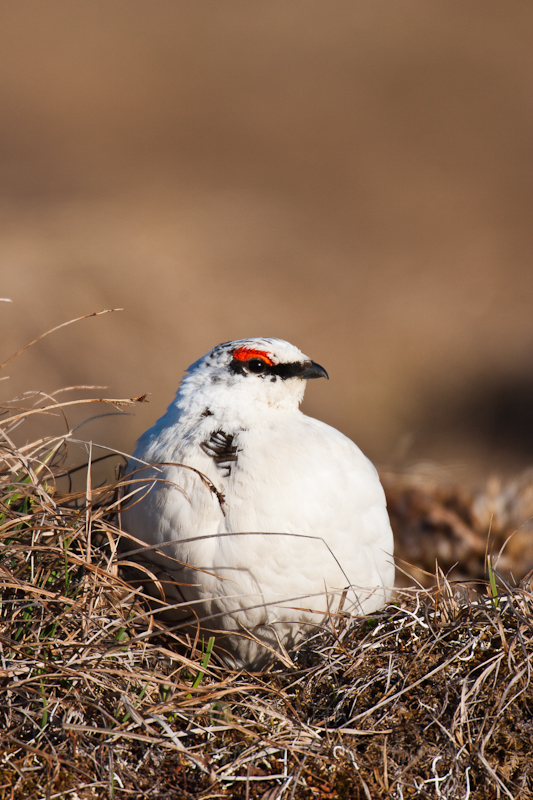Today our Avian Retrospective moves north into the wild country of the Arctic National Wildlife Refuge. In June 2007, I guided a custom photography trip for Arctic Wild to the coastal plain of the refuge. The two clients and I spent a great week photographing the birds of the area. We had two base camps during the week. The first was about midway between the coast and the mountains along the Canning River. The second was a mile or two from the Arctic Ocean on the delta of Canning. Notably, both these camps were located in the western portion of the infamous 1002 area, the part of the refuge constantly under threat of industrial oil development. Despite the rhetoric (and vitriol in the case of Alaska’s heartless congressman Don Young) of drilling supporters the coastal plain is in no way, shape or form an empty and desolate place. It is a spectacular, wide-open landscape. Lakes, ponds and expansive tundra grasslands sweep from horizon to horizon, and during June it is filled with birds (and caribou, bears, wolves, muskoxen, foxes, etc.). Drilling there would be a shame and a travesty.
At any rate both these images of male Rock Ptarmigan were made at the upper camp, a day apart. The first shot I made under conditions that would not normally be associated with good bird photography. It was near mid-day, the light is hard and bright, and striking the bird from the right side of the frame. However, the interesting terrain of the big-rock gravel bar, and the dark blue, shadowed background (created by a riverside bluff), add some visual interest to the image. The blues, grays and whites, add an almost monochrome appearance to the photo. The only flash of color comes in the narrow red eyebrow of the ptarmigan. I don’t like that the bird’s face is partly in shadow, which reduces the clarity around the eye. I also wish the dark blue of the upper left background extended across the frame instead of blurring out into more pale whites and grays on the upper right. If I laid down on the rocks and gotten a lower perspective, it would have helped the image substantially. Still I like this shot, I like the rolling formation of the rocks and the way the bird echoes those patterns.
Verdict? Though flawed the image is sharp and visually interesting.
This second image was made the first evening (late night actually) of the trip. We hiked up onto the dry ground of the bluffs surrounding our camp and found this bird sitting conspicuously atop a tussock. Male Rock Ptarmigan, unlike the females, hold onto their white plumage long into summer. This would seem an invitation to predators, and it is, purposefully so. They stand out to draw attention away from the nesting females. Somewhere not far away the mate of this bird, likely sat perfectly camouflaged on her nest, and not surprisingly, we never found her. This bird was extremely patient, allowing us to approach within a few yards before he started to look a little nervous and we backed off. This image is quite good overall. It is sharp, the front-light is excellent, the background is clean and lacking distraction. The tussock perch is visually interesting and provides at least a hint of the habitat on the coastal plain. Despite the difficulty of metering the white bird, sunlight and dark-brown foreground, the exposure is dead-on. Lastly the composition provides plenty of dead space at the top of the image for text or design elements. So all good right? I’d say yes. But it isn’t a Wow! image. This is great shot, well composed and executed but it doesn’t have that umph, that a truly spectacular image does. Also this shot was a long time in the making. I made probably 200 images of this bird that evening and this one came somewhere at the end of that process. In other words there was a lot of trial and error to get it right. That is a very rare luxury in wildlife photography as we are not often afforded the time to experiment. Most cases, we need to get the shot right the first time, because there is rarely a second chance. My first few images of this bird are wildly under-exposed and poorly composed, had the bird flown off after those frames snapped off, I would have come home with nothing.
The verdict: Lacking Wow! factor, but a very strong image.
If you’d like prints or digital downloads of these or other ptarmigan images you can purchase them right here.
Related posts:
Today (after a request from a friend) I'm going to feature a ...
After 17 days of canoeing, hiking, photography, rain and wind dodging, ...
A Black-browed Albatross glides over the churning waters of the South Atl...


love the first one, and I’ve been enjoying the critiques
Dave, thanks for your message about the vibrancy of the 1002 Area. I’m enjoying reading your entries. Only a confident artist could admit to the flaws in their image… This really struck me when you pointed out that your shot of the bird on the tussocks was late in a set of 200 images. Thanks for helping to inspire those of us with less skill but a mutual love of photography.
I hope you don’t mind, but I passed this site along to the Arctic Refuge Manager, who also pursues photography in big, wild places.